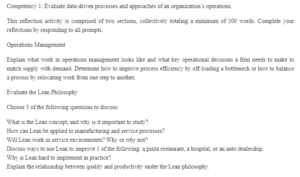Lean Implementation Reflection
How can Lean be applied to manufacturing and service processes?
Lean can be applied to manufacturing processes through a simple manufacturing system, using metrics to assess the effectiveness of improvements and implementing a continuous improvement program. Simple manufacturing includes following a streamlined process that applies a pull system to produce products based on demand. The most effective approach in simple manufacturing is using the Kanban system, which uses visual signs to control the flow of materials within the supply chain, resulting in a reduction in waste arising from producing too much, reducing inventory, improving workflow, and increasing productivity by reducing work-in-progress (Lehekar, & Urne, 2017). Continuous improvement includes the application of Kaizen, which is characterized by a culture where everyone, including top management, finds ways to improve the company. The use of metrics to assess the effectiveness of improvements includes using tools such as Statistical Process Control, which incorporates the use of a control chart to record information and monitor progress to determine when a process stops working. Lean can be applied in service processes using lean techniques and tools aimed at improving customer experience by eliminating or reducing unnecessary activities such as the number of customer calls transferred and maximizing the empowerment of employees to make them more productive.
Will Lean work in service environments? Why or why not?
Lean will work in service environments because companies in the climate identify their components that are repetitive and similar to an assembly line. The service environment also operates using the pull system applied in lean whereby the customer demands pull services through the production process because a service can only be provided if there is a customer on the receiving end. Lean can, therefore, be used to improve the overall efficiency, customer satisfaction, and quality of businesses in the service environment. Lean can also help in optimizing the service delivery process by focusing on wastes and either eliminating them or moving to a more effective state as part of the move towards continuous improvement. It would also play a significant role in improving employee satisfaction, ensuring that support activities focus on delivering value and increasing customer value. We offer assignment help with high professionalism.
Why is Lean hard to implement in practice?
One of the challenges in the implementation of lean in practice is limited leadership and communication in the implementation phase, thus making it hard for those required to implement it to determine what should be done. The second challenge is disagreement on how value should be defined. In most instances, organizations fail to direct employees on defining value, thus making it hard to access improvement processes and create a connection between quality and value. Lean implementation also relies on employee involvement. According to Bakke & Johansen (2019), the most crucial slight thinking challenges are mainly related to the lack of understanding of the cultural aspect of the concept, which in most cases is not compatible with the management philosophy in the modern business environment.
Explain the relationship between quality and productivity under the Lean philosophy.
According to the lean philosophy, production is aimed at improving the performance of processes. The performance of operations can be measured based on the quality of the output, the cost incurred in creating the production, and delivery time. These variables are connected, thus placing an equal significance on delivery, price, and quality and ensuring that the most essential products and services are processed first and in the most efficient way. Therefore, the more productive an assembly line is, the more units it can provide and the more the emphasis on quality. In addition, the more accurate the match between the items produced and the purchased components, the higher the level of productivity.
References
Bakke, A. L., & Johansen, A. (2019). Implementing lean – challenges and lessons learned. Procedia Computer Science, 164, 373-380. https://doi.org/10.1016/j.procs.2019.12.196
Lehekar, M. P., & Urne, M. (2017). Implementation of Kanban. International Journal of Trend in Scientific Research and Development, Volume-1(Issue-6), 598-621. https://doi.org/10.31142/ijtsrd4616
ORDER A PLAGIARISM-FREE PAPER HERE
We’ll write everything from scratch
Question

Lean Implementation Reflection
Competency 1: Evaluate data-driven processes and approaches of an organization’s operations.
This reflection activity is comprised of two sections, collectively totaling a minimum of 500 words. Complete your reflections by responding to all prompts.
Operations Management
Explain what work in operations management looks like and what vital operational decisions a firm needs to make to match supply with demand. Determine how to improve process efficiency by off-loading a bottleneck or how to balance a process by relocating work from one step to another.
Evaluate the Lean Philosophy
Choose 3 of the following questions to discuss:
What is the Lean concept, and why is it important to study?
How can Lean be applied to manufacturing and service processes?
Will Lean work in service environments? Why or why not?
Discuss ways to use Lean to improve 1 of the following: a pizza restaurant, a hospital, or an auto dealership.
Why is Lean hard to implement in practice?
Explain the relationship between quality and productivity under the Lean philosophy.

